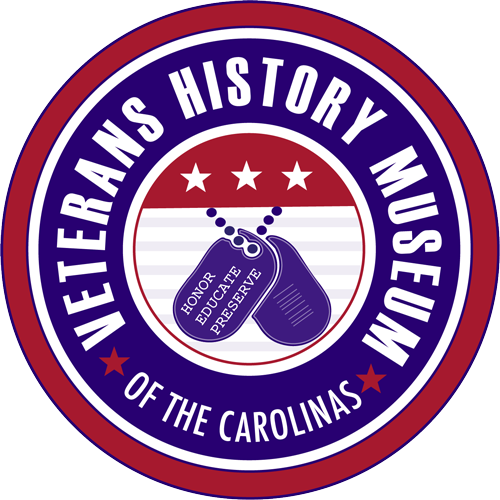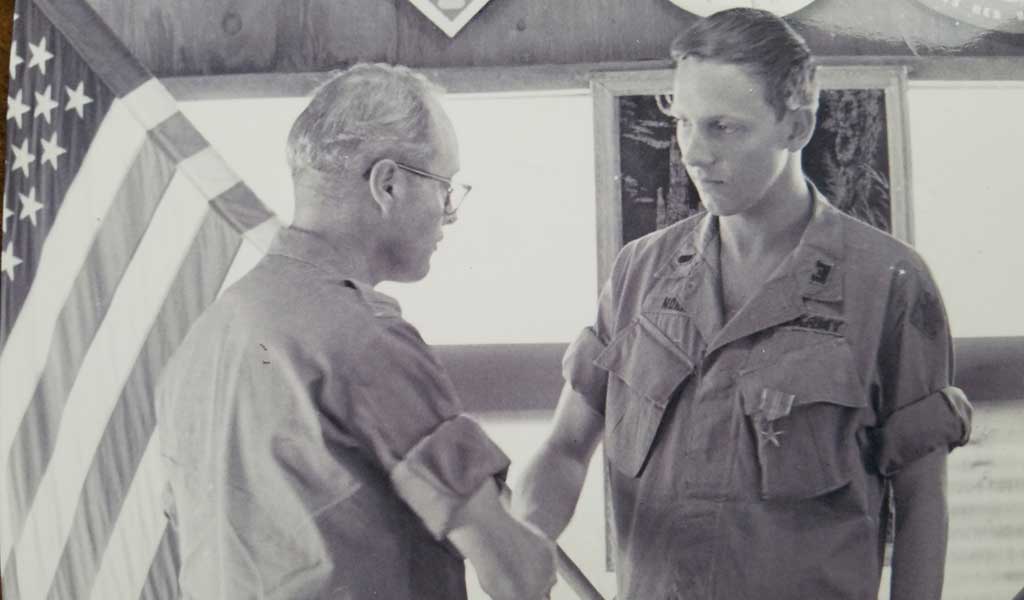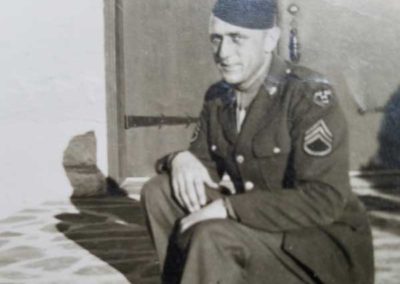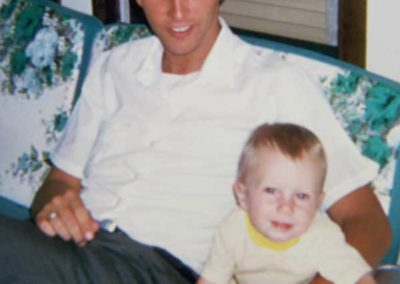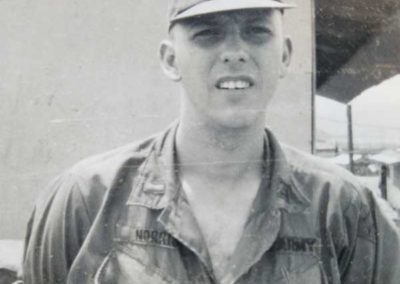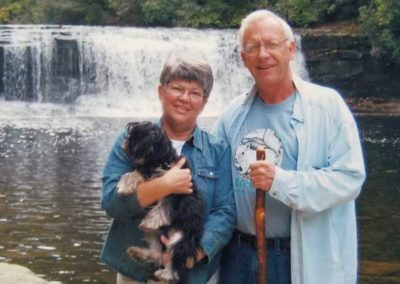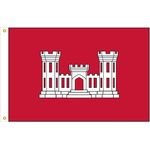Part I: Father
Ray J. Norris I was working in Toledo, Ohio when he was drafted into the U.S. Army on March 15, 1943 (37 years old) and was assigned to Camp Perry, Ohio. Later he was sent to Camp Hood, Texas to prepare for leaving for combat in World War II. It was during this time that he met my mother, Margaret Monica Ehly, a farm girl who was working as a volunteer at USO. SSgt Norris and Ms. Ehly were married on May 1, 1944 in Lampasas, Texas in St. Mary’s Church. He left for Service outside the Continental US on Dec 16, 1944.
The history below was compiled by Robert F. Jackson, 1st Lt. Inf (TD),
Acting Adjutant 656th Tank Destroyer Battalion APO 403.
SSgt Norris was assigned to the 656th Tank Destroyer Battalion in the Medical Detachment Company. The unit, commanded by LTC John Meador, landed in England on the last day of December 1944. It remained on the southern coast of England for almost a month. The unit moved across the English Channel in LSTs to France. From this camp the battalion marched across France and Belgium to the vicinity of Liege where it joined the 9th Armored Division.
On the 28th of February 1945 the battalion moved through Aachen, Germany and crossed the Roer River near Duren. Then as part of the armored spearhead, it fought east to Romagen and the Rhine River. On the 7th of March 1945 when the Ladendorf Bridge was captured intact by First Army troops, “destroyer” from Company “C” were the first Tank Destroyers to cross the Rhine River into the bridgehead. The entire battalion crossed over to the east side of the Rhine River and occupied direct fire positions during the expansion of the bridgehead.
When the First Army broke out of the Romagon Bridgehead, the battalion rolled southeast to Limburg, then turned and raced north to Warburg, taking in stride all of the resistance it met. A short rest, and the long march on Loipzig began. The battalion pushed far east as the Muldo River where units from the 69th Division took over and went on to meet the Russians.
After the Yanks and the Russians met, the battalion was assigned to the Third Army. It then moved to Weiden, near the Czechoslovakian border. A week or two later the unit moved to Bayrouth, Germany where it began preparations for the return home.
Raymond J. Norris I left Europe on June 23, 1945 returned to Camp Hood, Texas on July 2, 1945, in time to see Raymond J. Norris II born at McCloskey General Hospital in Temple Texas.
After discharge from the Army on August 31, 1945, the family moved back to Toledo, Ohio where we all made a home in South Toledo. My father Raymond J Norris I died in May, 1958, and my mother passed in August, 1972.
Part II of this story will recount the service of Raymond J Norris II
Summary of Part I
The father, SSgt Norris served in the 656th Tank Destroyer Battalion in the Medical Detachment Company in England, France and Germany, returning in July of 1945.
Part II: Son
Raymond (now also known as Ray) J Norris II (I dropped the II after my father passed) grew up in Toledo Ohio. I went to Immaculate Conception Catholic Elementary School, St Francis De Sales Catholic High School and The University of Toledo where I graduated with a Bachelor of Science in Civil Engineering.
During the short time I got to spend with my father, he did talk about his time in World War II and his experiences in Europe. He never talked about this time in his life with my mother that I was aware of. My dad did share two particular “words of wisdom” with me during our talks while he ran a small appliance repair business in the attic of our home. He said, “Son, if you ever have to go into the army, go as an officer, as it is always easier telling someone where to dig the hole than it ever is digging the hole.” The second bit of advice he gave me was to be kind and respectful of the enlisted men you command as it is those men that will bring you through as an officer.” I took his advice on both items of guidance.
Little did my father know that the war in Viet Nam would become very active when I was at the University of Toledo. I entered the ROTC Program (remembering my father’s advice) and when I graduated, I was commissioned as a Second Lieutenant in June 1968.
I entered active duty in the US Army on September 16, 1968, and was assigned to Fort Belvoir in Alexandria, Virginia to begin Engineer Officers Training. Upon my completion of this training, I was assigned to Ft. Riley in Junction City, Kansas to a Combat Engineer Battalion there in preparation for duty in Viet Nam.
I left for Viet Nam on August 24, 1969, assigned to the 27th Combat Engineer (Tiger) Battalion [18th Engineer Brigade, 45th Engineer Group] and was promoted to 1LT on September 16, 1969. This Combat Engineer Battalion took up operations in the I Corps Tactical Zone at Gia Le.
Our base camp was at Camp Eagle (101st Airborne) near Phu Bai and Hue, Viet Nam. I was initially assigned to be Platoon Leader in Company D at FSB Birmingham. Four months later I was assigned to the S-3 section of the Engineer Battalion since I was one of two civil engineers in the entire unit.
The basic charge of the battalion was to build Route 547 from Phu Bai to the A Shau Valley. My platoon unit camped at FSB (Fire Support Base) Birmingham, FSB Bastogne, and FSB Blaze. Each time we moved to a new FSB the artillery shelled the new location, the infantry would secure the site, and then our engineer unit (men and heavy equipment) would be airlifted to the site.
We would then dig in bunkers set up perimeters with towers and barbed wire. Since the artillery usually followed us to the new site, we would build gun pads for the howitzers who would fire around 200 rounds into the A Shau Valley every night. The camp was frequently mortared at night, so we were glad to have protected bunkers.
We would build a tracer road down from the new site to the planned area for the extension of Route 547. As we built each new section of road, our unit would then do mine-sweeping operations every morning. For the most part “Charlie” (the enemy) would leave us alone while we were building the roads and bridges as they used these at night. We always flew the large red engineer flag with the castle on all vehicles signifying we were the “engineers.” It usually worked well.
After I was assigned as the S-3, I developed a design team which put together a “engineer plan of action” for each unit in our battalion. I would then get a helicopter ride each day to deliver the plans to all of the outlying camps we were responsible for and meet with each officer to discuss the civil engineering plans for their unit.
One time when I went to visit the engineer unit at FSB T-Bone, they were under an active attack by “Charlie” in the middle of the day. Needless to say, I was glad to get back to base camp at Phu Bai that evening.
While I was in Nam, my son Douglas was born in November, 1969. I received many pictures of my son while I was in-country, but I did not get to see him until I returned to Toledo in August of 1970. It was a great and very happy experience for me to see him for the first time.
A second great experience for me was being award the Bronze Star for achievement while I was ending my tour in Nam. I just recently found out my father was awarded two Bronze stars during his tour with the 656th Tank Destroyers in World War II. Dad never talked about those medals with me when he told me about his experiences, however it gave me great pride about my father.
One last item of related military association in my family: My daughter Kimberlie Kay (Norris) England (who was born in May, 1973) is married to Colonel John Wojcik, a JAG officer in the Michigan National Guard based out of Lansing Michigan. He just recently celebrated 30 years in the service. Kimberlie enjoys the military side of her life.
Kimberlie introduced me to my wife Barbara on July 4, 2003 and we were married on the first day of spring, May 20, 2004. We came down to Brevard to visit some friends and fell in love with the people here and the area. We built and moved into our dream home in Eagle Lake on November 15, 2006. It overlooked the Blue Ridge Parkway and the Pisgah National Forest with great sunsets. While we loved this area and the folks at Eagle Lake (still do), we moved “off the mountain” and down to the city on November 9th, 2015. Barb and I still travel around the country with our dog Winston. We have camped in 42 states and been to 23 National Parks. We also enjoy very much the people here in Brevard and our extended family at Sacred Heart Parish.
Life gives us many experiences to build on, but two of them were my discussions with my father about his experiences in World War II and my “young man growing up” happenings from Viet Nam. Not only the civil engineering events but the men (enlisted and other officers) I met along the way. I used those work and people skills I learned in my 31 years for the City of Toledo and for a private architect/engineer in Toledo as a civil engineer for 9 years. They all helped bring us to the wonderful city of Brevard, North Carolina.
Ray-Norris-seeing-his-son-Douglas-for-the-first-time-after-returning-from-Vietnam
Ray Norris seeing his son Douglas for the first time after returning from Vietnam
